Murat Uysal
Capacity-Optimized Pre-Equalizer Design for Visible Light Communication Systems
May 26, 2025Abstract:Since commercial LEDs are primarily designed for illumination rather than data transmission, their modulation bandwidth is inherently limited to a few MHz. This becomes a major bottleneck in the implementation of visible light communication (VLC) systems necessiating the design of pre-equalizers. While state-of-the-art equalizer designs primarily focus on the data rate increasing through bandwidth expansion, they often overlook the accompanying degradation in signal-to-noise ratio (SNR). Achieving effective bandwidth extension without introducing excessive SNR penalties remains a significant challenge, since the channel capacity is a non-linear function of both parameters. In this paper, we present a fundamental analysis of how the parameters of the LED and pre-equalization circuits influence the channel capacity in intensity modulation and direct detection (IMDD)-based VLC systems. We derive a closed-form expression for channel capacity model that is an explicitly function of analog pre-equalizer circuit parameters. Building upon the derived capacity expression, we propose a systematic design methodology for analog pre-equalizers that effectively balances bandwidth and SNR, thereby maximizing the overall channel capacity across a wide range of channel attenuations. We present extensive numerical results to validate the effectiveness of the proposed design and demonstrate the improvements over conventional bandwidth-optimized pre-equalizer designs.
Placement, Orientation, and Resource Allocation Optimization for Cell-Free OIRS-aided OWC Network
Jan 06, 2025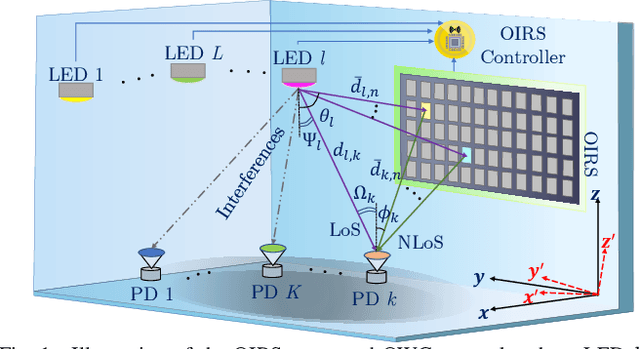
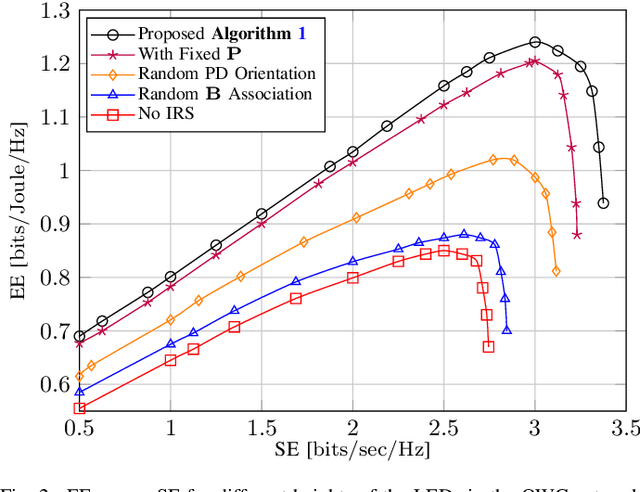
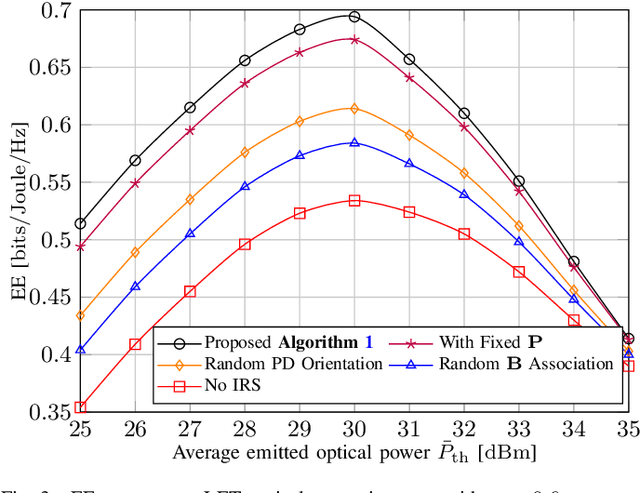
Abstract:The emergence of optical intelligent reflecting surface (OIRS) technologies marks a milestone in optical wireless communication (OWC) systems, enabling enhanced control over light propagation in indoor environments. This capability allows for the customization of channel conditions to achieve specific performance goals. This paper presents an enhancement in downlink cell-free OWC networks through the integration of OIRS. The key focus is on fine-tuning crucial parameters, including transmit power, receiver orientations, OIRS elements allocation, and strategic placement. In particular, a multi-objective optimization problem (MOOP) aimed at simultaneously improving the network's spectral efficiency (SE) and energy efficiency (EE) while adhering to the network's quality of service (QoS) constraints is formulated. The problem is solved by employing the $\epsilon$-constraint method to convert the MOOP into a single-objective optimization problem and solving it through successive convex approximation. Simulation results show the significant impact of OIRS on SE and EE, confirming its effectiveness in improving OWC network performance.
Multi-Hop Quantum Key Distribution with Passive Relays over Underwater Turbulence Channels
Jun 13, 2022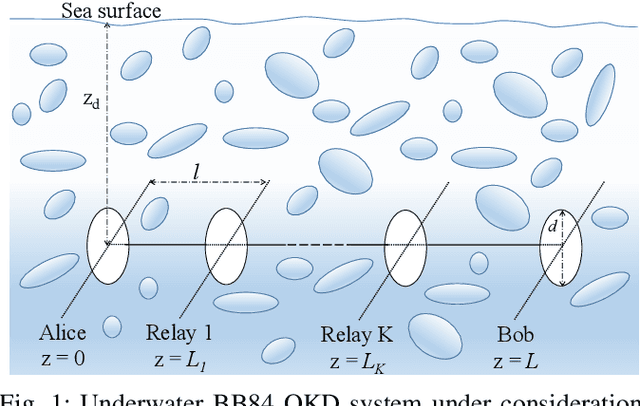
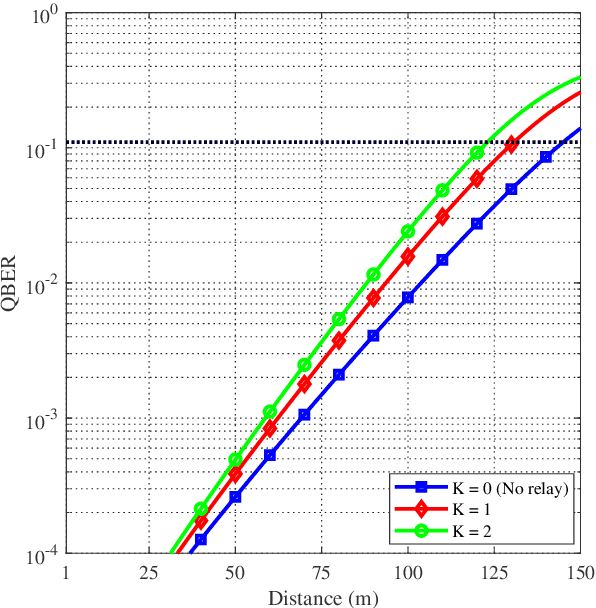
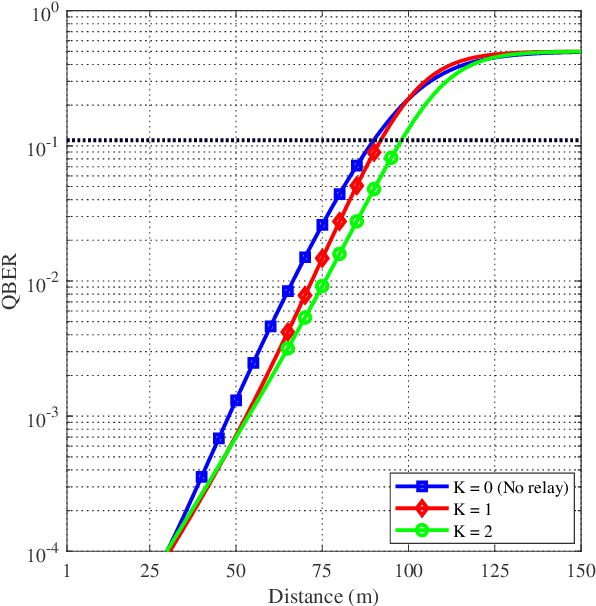
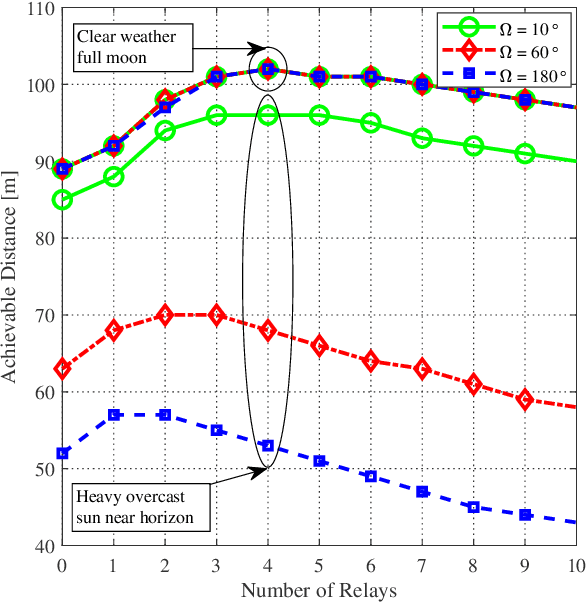
Abstract:Absorption, scattering, and turbulence experienced in underwater channels severely limit the range of quantum communications. In this paper, to overcome range limitations, we investigate a multi-hop underwater quantum key distribution (QKD) where intermediate nodes help the key distribution between the source and destination nodes. We consider deployment of passive-relays which simply redirect the qubits to the next relay node or receiver without any measurement. Based on near-field analysis, we present the performance of relay-assisted QKD scheme in clear ocean under different atmospheric conditions. We further investigate the effect of system parameters (aperture size and detector field-of-view) on the achievable distance.
Modulating Retroreflector Based Free Space Optical Link for UAV-to-Ground Communications
Feb 26, 2022


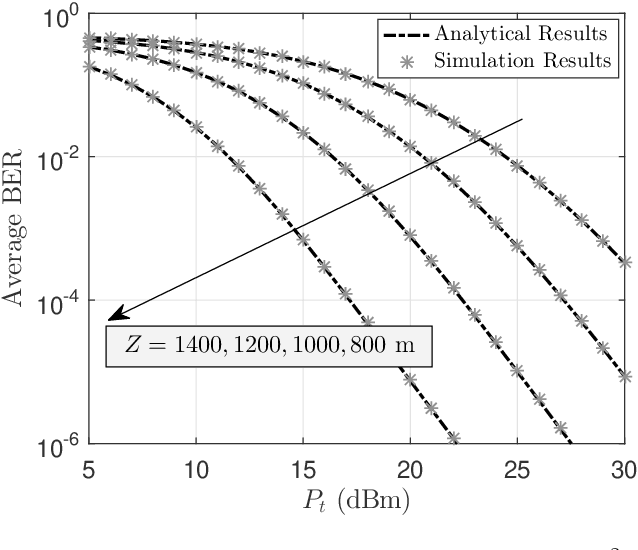
Abstract:Weight reduction and low power consumption are key requirements in the next generation of unmanned aerial vehicle (UAV) networks. Employing modulating retro-reflector (MRR)-based free space optical (FSO) technology is an innovative technique for UAV-to-ground communication in order to reduce the payload weight and power consumption of UAVs which leads to increased maneuverability and flight time of UAV. In this paper, we consider an MRR-based FSO system for UAV-to-ground communication. We will show that the performance of the considered system is very sensitive to tracking errors. Therefore, to assess the benefits of MRR-based UAV deployment for FSO communications, the MRR-based UAV FSO channel is characterized by taking into account tracking system errors along with UAV's orientation fluctuations, link length, UAV's height, optical beam divergence angle, effective area of MRR, atmospheric turbulence and optical channel loss in the double-pass channels. To enable effective performance analysis, tractable and closed-form expressions are derived for probability density function of end-to-end signal to noise ratio, outage probability and bit error rate of the considered system under both weak-to-moderate and moderate-to-strong atmospheric turbulence conditions. The accuracy of the analytical expressions is verified by extensive simulations. Analytical results are then used to study the relationship between the optimal system design and tracking system errors.
Measurement Based Non-Line-Of-Sight Vehicular Visible Light Communication Channel Characterization
Nov 22, 2021



Abstract:Vehicular visible light communication (V-VLC) aims to provide secure complementary vehicle to everything communications (V2X) to increase road safety and traffic efficiency. V-VLC provides directional transmissions, mainly enabling line-of-sight (LoS) communications. However, reflections due to nearby objects enable non-line-of-sight (NLoS) transmissions, extending the usage scenarios beyond LoS. In this paper, we propose a wide-band measurement-based NLoS channel characterization and evaluate the performance of direct current biased optical orthogonal frequency division multiplexing (DCO-OFDM) V-VLC scheme for NLoS channel. We propose a distance-based NLoS V-VLC channel path loss model considering reflection surface characteristics and NLoS V-VLC channel impulse response (CIR) incorporating the temporal broadening effect due to vehicle reflections through weighted double gamma function. The proposed path loss model yields higher accuracy up to 14 dB when compared to the single order reflection model whereas the CIR model estimates the full width at half maximum up to 2 ns accuracy. We further demonstrate that the target bit-error-rate of 10^-3 can be achieved up to 7.86 m, 9.79 m, and 17.62 m distances for black, orange, and white vehicle reflection induced measured NLoS V-VLC channels for DCO-OFDM transmissions.
Space-Time Block Coded Spatial Modulation for Indoor Visible Light Communications
Nov 06, 2021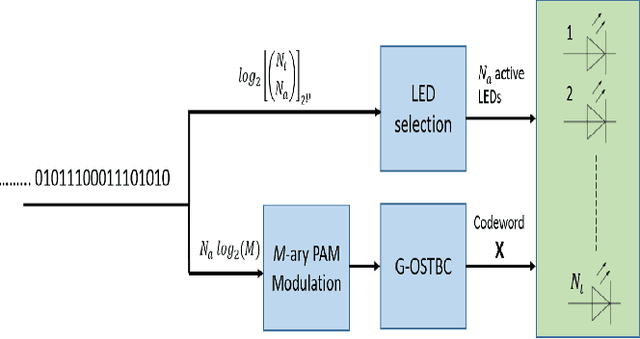
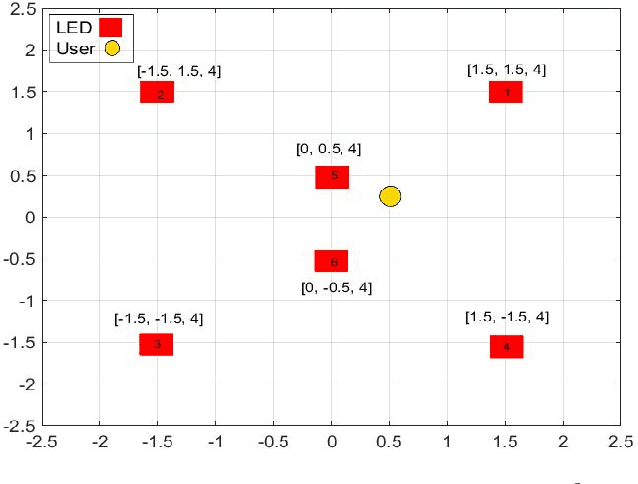
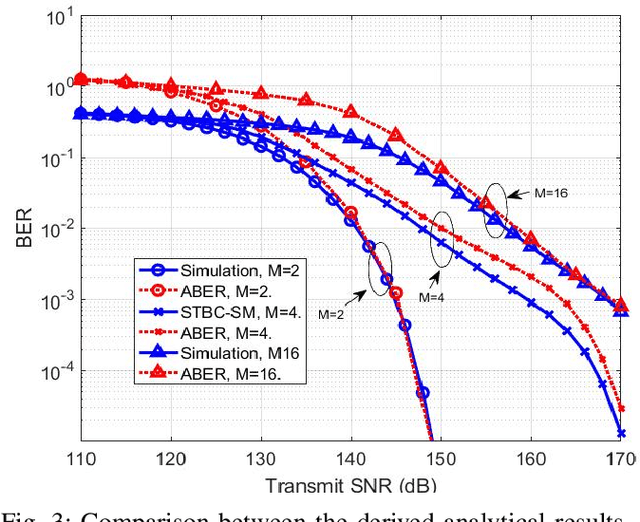
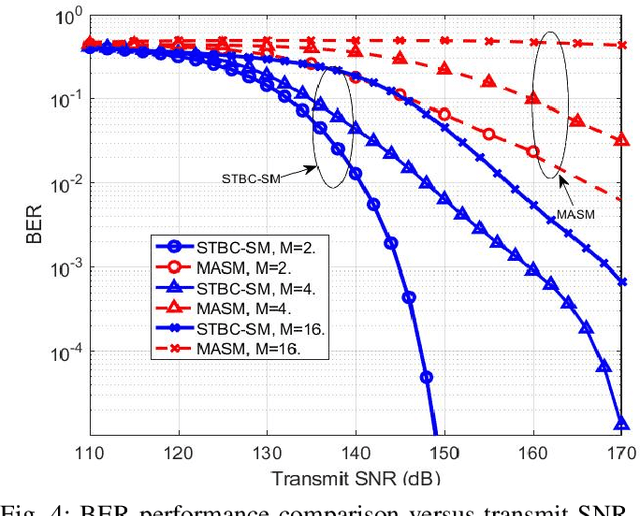
Abstract:Visible light communication (VLC) has been recognized as a promising technology for handling the continuously increasing quality of service and connectivity requirements in modern wireless communications, particularly in indoor scenarios. In this context, the present work considers the integration of two distinct modulation schemes, namely spatial modulation (SM) with space time block codes (STBCs), aiming at improving the overall VLC system reliability. Based on this and in order to further enhance the achievable transmission data rate, we integrate quasi-orthogonal STBC (QOSTBC) with SM, since relaxing the orthogonality condition of OSTBC ultimately provides a higher coding rate. Then, we generalize the developed results to any number of active light-emitting diodes (LEDs) and any M-ary pulse amplitude modulation size. Furthermore, we derive a tight and tractable upper bound for the corresponding bit error rate (BER) by considering a simple two-step decoding procedure to detect the indices of the transmitting LEDs and then decode the signal domain symbols. Notably, the obtained results demonstrate that QOSTBC with SM enhances the achievable BER compared to SM with repetition coding (RC-SM). Finally, we compare STBC-SM with both multiple active SM (MASM) and RC-SM in terms of the achievable BER and overall data rate, which further justifies the usefulness of the proposed scheme.
 Add to Chrome
Add to Chrome Add to Firefox
Add to Firefox Add to Edge
Add to Edge